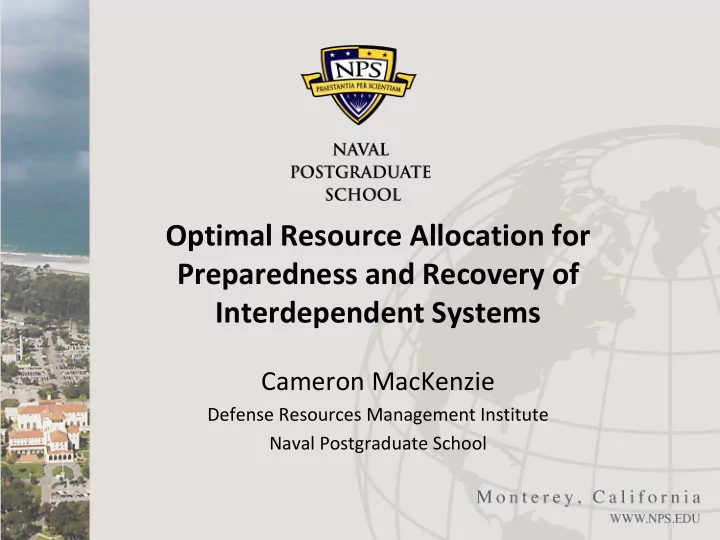

Optimal Resource Allocation for Preparedness and Recovery of Interdependent Systems Cameron MacKenzie Defense Resources Management Institute Naval Postgraduate School
Prevention, preparedness, response 2
Research questions • What is the optimal allocation of resources pre-disruption (prevention and preparedness) and post-disruption (response and recovery)? • How should resources be allocated among different industries to help those industries recover? 3
Deepwater Horizon oil spill 4
Key assumptions • Objective function minimizes expected economic impact of a disruption • Preparedness resources reduce chances of disruption • Response resources reduce economic impact of disruption – Allocation to individual industries – Allocation to all industries 5
Impacted area Texas, Louisiana, Mississippi, Alabama, and Florida 6
Directly impacted industries Real estate Fishing Accommodations Oil and gas Amusements 7
Resource allocation model Interdependent matrix Normal production Increased production min 𝑞𝐲 ⊺ 𝐄𝐝 − 1 − 𝑞 𝑎 − 𝑨 𝑞 if no disruption Vector of direct impacts (proportional) Probability of disruption Effectiveness of Probability with Allocation to prepare preparedness allocation no resources subject to 𝑞 = 𝑞 exp −𝑙 𝑞 𝑨 𝑞 Allocation to benefit all industries Allocation to industry Direct impacts with no resources 𝑑 𝑗 = 𝑑 𝑗 exp −𝑙 𝑗 𝑨 𝑗 − 𝑙 𝐻𝑓𝑜𝑓𝑠𝑏𝑚 𝑨 𝐻𝑓𝑜𝑓𝑠𝑏𝑚 Effectiveness of recovery allocation i = { Fish , Real Estate , Amusements , Accommodations , Oil } 𝑨 𝑞 + 𝑨 𝐺𝑗𝑡ℎ + 𝑨 𝑆𝑓𝑏𝑚𝐹𝑡𝑢𝑏𝑢𝑓 + 𝑨 𝐵𝑛𝑣𝑡𝑓 + 𝑨 𝐵𝑑𝑑𝑝𝑛 + 𝑨 𝑝𝑗𝑚 + 𝑨 𝐻𝑓𝑜𝑓𝑠𝑏𝑚 ≤ 𝑎 𝑨 𝑞 ≥ 0, 𝑨 𝑗 ≥ 0 , 𝑨 𝐻𝑓𝑜𝑓𝑠𝑏𝑚 ≥ 0 Overall budget 8
Input parameters for oil spill 𝑙 𝑞 = 0.0031 𝑞 = 0.045 Preparedness 𝑙 𝐻𝑓𝑜𝑓𝑠𝑏𝑚 = 8.6*10 -5 All industries 𝒋 𝒍 𝒋 (per $1 mil) 𝒅 Industry Fishing 0.074 0.0084 Real estate 0 0.047 Amusements 0.0038 0.21 Accommodations 0.0027 0.16 Oil and gas 0.0057 0.079 9
Parameter estimation for fishing $62 million lost sales from Gulf Coast fishing 0.84% of region’s fishing and forestry production Studies on food safety and impact of positive media stories $792,000 to reduce losses by $40 million 10
Allocation for prevention 11
Allocation for response 12
Sensitivity analysis for prevention Proportion of $10B budget allocated for preparedness Probability of oil spill 𝑞 Effectiveness of allocating for preparedness 𝑙 𝑞 13
Sensitivity analysis for 𝒉 𝒂 − 𝒜 𝒒 14
Sensitivity analysis for response Proportion of budget allocated to all industries Effectiveness of allocating to all industries 𝑙 𝐻𝑓𝑜𝑓𝑠𝑏𝑚 (× 10 -4 ) 15
Allocation to all industries 𝑨 𝐻𝑓𝑜𝑓𝑠𝑏𝑚 > 0 if 𝑙 𝐻𝑓𝑜𝑓𝑠𝑏𝑚 > 𝑙 ∗ Column of interdependent Allocation to prepare Overall budget matrix −1 1 𝑙 𝑗 𝑨𝑗>0 exp 𝑎 − 𝑨 𝑞 𝑙 ∗ = 1 1 𝐲 ⊺ 𝐞 ∗𝑗 𝑑 𝑗 + 𝑙 𝑗 𝐲 ⊺ 𝐞 ∗𝑗 𝑑 𝑗 𝑙 𝑗 1 𝑙 𝑗 𝑨 𝑗 >0 𝑨 𝑗 >0 𝑨 𝑗 =0 Direct impacts Effectiveness of Normal production with no recovery resources allocation 16
Preliminary conclusions • Allocating to prevent a disruption may be small compared to allocation to respond – Assumptions that prevention reduces chances of disruption – Assumption that money not allocated to prevention can increase regional production if no disruption • Pre-disruption allocation should increase if – Preparedness reduces impacts – Decision maker is risk averse 17
Preliminary conclusions • As budget increases, greater incentive for response allocation to be allocate to benefit all industries versus targeting individual industries • Future research can include multiple scenarios Email: camacken@nps.edu 18
Recommend
More recommend